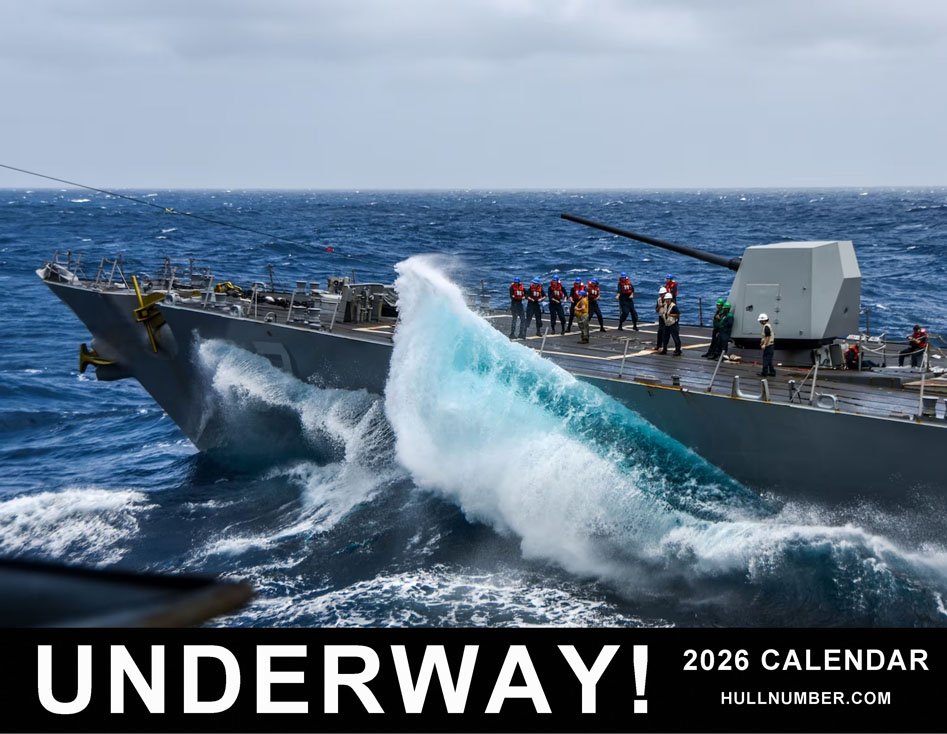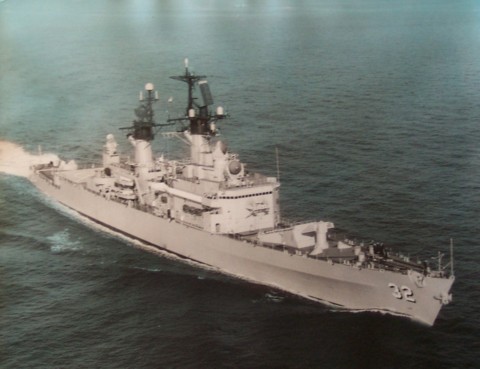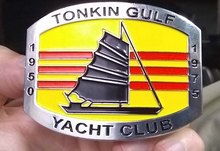 |
|||||||
| UNDERWAY! 2026 WALL CALENDAR is AVAILABLE - CLICK HERE |
|||||||
 |
|||||||
 |


U.S.S. WILLIAM H. STANDLEY
(CG-32)STANDLEY STEAMER
Click to view crew list
USS WILLIAM H. STANDLEY (CG-32) - a Belknap class cruiser
In Commission 1966 to 1994CG-32 Deployments - Major Events
| Add a CG-32 Shellback Initiation | Add a CG-32 Deployment - Major Event | ||||
| Month | Year | to | Month | Year | Deployment / Event |
|---|---|---|---|---|---|
| JUL | 1963 | - | Keel Date: 29 JUL 1963 at Bath Iron Works Bath ME | ||
| DEC | 1964 | - | Launch Date: 19 DEC 1964 | ||
| JUL | 1966 | - | Commissioned: 9 JUL 1966 | ||
| OCT | 1967 | - | MAR | 1968 | Mediterranean |
| MAY | 1968 | - | JUN | 1968 | Search for USS Scorpion |
| JUL | 1968 | - | JAN | 1969 | West Pac-Viet Nam |
| JUL | 1969 | - | JUL | 1969 | Sellback Initiation |
| JUL | 1969 | - | Shellback Initiation - 13 JUL 1969 - Pacific Ocean | ||
| JAN | 1971 | - | AUG | 1971 | West Pac |
| JUL | 1971 | - | Shellback Initiation - 19 JUL 1971 - Indian Ocean | ||
| JUN | 1972 | - | DEC | 1972 | Mediterranean |
| JUN | 1974 | - | DEC | 1974 | Mediterranean |
| OCT | 1975 | - | MAY | 1976 | Mediterranean |
| OCT | 1975 | - | Shellback Initiation - 27 OCT 1975 - Atlantic Ocean | ||
| FEB | 1977 | - | AUG | 1977 | Mediterranean |
| SEP | 1977 | - | SEP | 1977 | Panama Canal |
| NOV | 1979 | - | JUN | 1980 | Mediterranean-Indian Ocean-Persian Gulf |
| DEC | 1979 | - | JUN | 1980 | West Pac-Indian Ocean-Persian Gulf |
| JAN | 1980 | - | Shellback Initiation - 10 JAN 1980 - Indian Ocean | ||
| JAN | 1980 | - | Shellback Initiation - 10 JAN 1980 - Pacific Ocean | ||
| JAN | 1980 | - | Shellback Initiation - 12 JAN 1980 - Pacific Ocean | ||
| JUN | 1981 | - | DEC | 1981 | West Pac-Indian Ocean-Persian Gulf |
| SEP | 1984 | - | SEP | 1984 | Panama Canal |
| SEP | 1986 | - | DEC | 1986 | RIMPAC |
| MAY | 1987 | - | MAY | 1987 | West Pac-Indian Ocean-Persian Gulf |
| AUG | 1987 | - | JAN | 1988 | West Pac-Indian Ocean-Persian Gulf |
| DEC | 1987 | - | Shellback Initiation - 10 DEC 1987 - Pacific Ocean | ||
| FEB | 1989 | - | AUG | 1989 | West Pac-Indian Ocean-Persian Gulf |
| MAY | 1989 | - | Shellback Initiation - 15 MAY 1989 - Indian Ocean | ||
| MAR | 1991 | - | DEC | 1991 | Desert Storm |
| DEC | 1992 | - | APR | 1993 | Somalia |
| FEB | 1994 | - | Decommissioned: 11 FEB 1994 | ||
CG-32 General Specifications
Complement: 418 Officers and Enlisted
Displacement: 7930 tons
Length: 547 feet
Beam: 55 feet
Draft: 28 feet 10 inches
Flank Speed: 30 knots
USS WILLIAM H. STANDLEY (CG-32)
William
H. Standley (DLG-32)
was laid down on 29 July
1963 at Bath, Maine, by the Bath Iron Works; launched on 19 December 1964;
sponsored by Mrs. Charles
B. Wincote, daughter of the late Admiral Standley; and commissioned on 9 July 1966, Capt. C. F. Moul in command.
Following fitting-out and
ship's qualification trials, William H.
Standley spent the holiday season
in Boston before heading for Guantanamo Bay, Cuba, in January 1967.
After a two and one-half month shakedown period,
William H. Standley became flagship for Rear Admiral E. R. Bonner, Commander, Cruiser Destroyer Flotilla 6, during a "Springboard"
exercise 'in the Caribbean. After
highlighting the cruise with port visits to San Salvador and San Juan,
Puerto Rico, the guided-missile frigate returned to Boston in April for post-shakedown availability.
On 12
June 1967, William H. Standley departed Boston and spent five weeks on operations with the Operational Test and Evaluation Force. During that
voyage, she touched at Santa Cruz de Tenerife, Canary Islands, a spot seldom visited by naval vessels.
Subsequently arriving at her first
home port, Mayport, Fla., on 14 July
1967, William H. Standley became the flagship for Commander, Destroyer Squadron (ComDes Ron) 8 the
following week.
Following
an underway period on the Atlantic Fleet Weapons
Range and a visit to Frederikstad, St. Croix, Virgin
Islands, William H. Standley prepared for her first deployment to the Mediterranean. On 6 October
1967, the guided-missile frigate
stood out to sea, leaving Mayport in her wake, bound for the ship's first tour of duty with the 6th Fleet.
Transiting
the Atlantic in company with Goodrich (DDR-831) and Turner (DDR-834), William
H. Standley joined Task Group (TG) 60.2 as
flagship for ComDesRon 8 upon her arrival
in the Mediterranean. While attached to the
6th Fleet, the guided-missile frigate
witnessed the rapid build-up of Soviet naval strength in the Mediterranean basin and visited the ports of Palma de
Majorca, Spain; Valetta, Malta; Naples, Italy; and Suda Bay, Crete.
For the
first three months of 1968, William H. Standley participated in a bilateral exercise with French naval units, "Phiblex
10-68," and conducted picket duty in the eastern Mediterranean, before she
sailed for home late
in March 1968.
Arriving
back at her home port on the 28th, William H. Standley spent a month undergoing
post-deployment upkeep,
before she conducted planeguard duty for Intrepid (CVS-11) in May. Soon thereafter, she responded to an emergency recall
and got underway to search for the
missing Scorpion (SSN-589), the atomic submarine
that had disappeared somewhere south of the Azores while en route back to the United States from a Mediterranean deployment.
William
H. Standley conducted
an Atlantic transit with
ComDesRon 8 embarked and, in company with five submarines and four destroyers, took part in the extensive hunt for the missing
submarine. The Navy officially declared Scorpion
as lost on 5 June; and William H.
Standley returned to Mayport the
following day.
Later in
June, the guided missile frigate embarked 40 midshipmen and took those officers-to-be on their summer cruise before disembarking
them at Norfolk, Va.,
late in July. William H. Standley entered the Charleston (S.C.) Naval Shipyard early in August for restricted availability and received alterations
that would permit her to function as
a PIRAZ (Positive Identification
Radar and Advisory Zone) ship to conduct
operations in Southeast Asia.
After
sea trials and a final in-port period at May-port, William H. Standley departed
her home port on 2
December for her first deployment to the Western Pacific (WestPac) area. After a brief stop at the Atlantic Fleet Weapons Range at
San Juan, Puerto Rico,
William H. Standley proceeded onward, transiting the Panama Canal for the first
time on 9 December.
Reaching
Hawaii in time for Christmas, William. H. Standley subsequently departed Pearl
Harbor after the Yuletide
holidays and reached Subic Bay, Philippines, early in January 1969 to receive new equipment and
run sea trials.
Departing
Subic Bay on 23 January for the Gulf of Tonkin, William H. Standley arrived on station and relieved Mahan (DLG-11)
as PIRAZ ship. During her month on
station, the guided missile frigate maximized the
use of her communications systems and her tactical data collection facilities, contributing
significantly to 7th Fleet operations
off the coast of Vietnam.
Relieved
by Mahan on 25 February, William H. Standley sailed for Japan and reached
Sasebo five days later
for upkeep and recreation. Departing that Japanese port on 14 March, the guided missile frigate arrived at Subic Bay on the 17th
for three days of training.
Resuming
her operations in Vietnamese waters on 22 March, William H. Standley began a
"difficult and demanding line period." Tensions in Korea had erupted,
causing the American
naval forces in the Par East to go on alert. North Korean and American forces had exchanged
fire briefly near the demilitarized zone between the two Koreas on 11 March;
and, on 15 April, North
Korean fighters downed an EC-121 reconnaissance plane over international waters in the Sea of Japan. The plane, based at
Atsugi, Japan, crashed with 31 men on
board.
During
her 50 days on the "line," William H. Stand-ley spent approximately half the time
on PIRAZ station and
half on the southern Sea Air Rescue (SAR) station. Operational requirements necessitated the southward movement and required
the ship to base two
helicopters simultaneously. William H. Standley met the test, earning a
commendatory message from Rear Admiral E. J. Rudd, entitled: "Stellar Standley."
Relieved
by King (DLG-10) on station, William H. Standley sailed to Hong Kong for some
well-earned rest and
recreation, arriving at the British Crown Colony
on 18 May. Departing on the 24th, the guided missile
frigate sailed for Japanese waters and reached Yokosuka on 28 May.
William
H. Standley returned
to the "line" after eight days of intensive upkeep, relieving Sterett (DLG-31) as
southern SAR ship on 9 June. For the next nine days, the guided missile frigate acted as SAR and strike support ship for the
aircraft carriers stationed in the Gulf
of Tonkin. Relieved by Chicago (CG-11) on 18 June, William H. Standley reached Pearl Harbor on Independence Day, pushing on for the Galapagos the
next day. Transiting the Panama Canal
on 16 July, the guided missile
frigate reached Mayport on 20 July.
From
September through the year's end, William H. Standley remained at Mayport, preparing for
her second WestPac cruise. Underway on 5
January 1971, the guided missile frigate
transited the Panama Canal four days later, and reached Pearl Harbor on the
23d. After four days in Hawaii, the
ship took in her lines and headed for
the Marianas, arriving at Guam on 5 February for a six-hour fueling stop.
Upon
leaving Guam, William H. Standley set course for Subic Bay and, after
assisting a merchantman in distress, the Philippine freighter Santa Anna, reached her destination on 10 February.
Two days later, she sailed
for the Gulf of Tonkin.
For the next 25 days, William
H. Standley escorted Ranger (CVA-61) on the northern SAR station, before she put into Sasebo for a port visit. After
brief patrol duty in the Sea of Japan,
the guided missile frigate returned to
the Gulf of Tonkin to serve as PIRAZ
vessel. She subsequently visited Hong Kong and Subic Bay (effecting rudder repairs at the latter port) and conducted one more PIRAZ tour before beginning
her homeward voyage.
Sailing
via Sattahip, Thailand; Singapore, Federated Malay States; Victoria, Seychelles; Lourenco Marques; the Cape of Good Hope; Rio de Janeiro, Brazil; and
Roosevelt Roads, Puerto Rico, William
H. Standley reached Mayport on 18
August, having circumnavigated the
globe and steamed some 51,000 miles. For the remainder of 1971, the guided missile frigate recuperated from the lengthy voyage, participating in
refresher training and conducting local operations off the Florida coast.
Departing
Mayport on 19 January 1972, William H. Standley took part in Operation "Snowy Beach" before
being detached on the 25th to proceed to Yorktown, Va., to take on weapons. Subsequently
returning to Mayport on
the 28th, the guided missile frigate departed her home port on 17 February to
participate in Atlantic Fleet exercises. During the course of this cruise, she visited the port of Nassau, New
Providence, Bahamas, and Port Everglades, Fla., before she returned to May-port on 9 March.
After her post-deployment
in-port period, William H. Standley exercised in the Caribbean as flagship forCommander,
Cruiser-Destroyer Flotilla (CruDesFlot) 6 that
autumn, conducting gunnery shoots-with both guns and missiles-at drone targets under wartime conditions. During her time in Caribbean waters,
the ship visited San Juan.
As the
year drew to a close, the guided missile frigate
prepared for her first major overhaul since commissioning. After entering the Charleston (S.C.) Naval Shipyard on 20
November 1969, William H. Standley spent the first half of 1970 in shipyard hands.
Upon
completion of that period of repairs and alterations, William H. Standley conducted missile
firings on the
Atlantic Fleet Weapons Range and trained at
Guantanamo Bay for six weeks, breaking those underway evolutions with visits to San Juan and to Port-au-Prince, Haiti.
Called away from her training on 5 August,
William H. Standley went to the aid of a foundering Panamanian merchantman off the northeastern tip of Hispaniola,
an "exacting seamanship evolution"
accomplished "very professionally."
Embarking
25 naval reservists on 20 March, William H. Standley stood out to sea on that day and
operated, for the
next nine days, off the eastern seaboard between Jacksonville, Fla., and Charleston, S.C. During
that time, she
conducted an antisubmarine warfare (ASW) exercise against Trutta (SS-421) and conducted LAMPS helicopter work-up, before
she returned to her home
port and remained there until 30 April.
The
guided missile frigate made one more exercise and spent one more period in port before she headed
out from Mayport,
bound for the Mediterranean and her
second tour with the 6th Fleet. Rendezvousing with TG 27.4, William H. Standley proceeded across the Atlantic. While she was en route, the guided
missile frigate's LAMPS helicopter
crashed at sea. Of the crew of four men, all but one were rescued. The
fourth man went down with the helicopter.
Reaching Rota, Spain, on 22
June, William H. Stand-ley completed turnover procedures with Harry E.
Yar-nell (DLG-17) and then joined Task Force (TF) 60 at sea. During her second deployment with the 6th
Fleet, William H. Standley participated in Operations "Good
Friendship," "Quick Draw," two "National Weeks," and "Bystander." She visited the ports of
Livorno, Italy; Cannes and Golfe
Juan, France; Palma, Majorca; Athens
and Corfu, Greece; Mersin and Izmir, Turkey; and Barcelona, Malaga, and Rota, Spain.
Departing Rota on 9 December,
William H. Standley transited the
Atlantic and arrived at her new home port, Charleston, S.C., a week before
Christmas of 1972. In port at
Charleston between 18 December 1972 and
17 January 1973, the guided missile frigate then underwent a seven and
one-half month overhaul. Following that
period of repairs and alterations, William H. Standley trained
locally and prepared for another Mediterranean deployment.
Departing Charleston on 14
June 1974, William H. Standley reached Rota on the 27th and, during the
early part of her tour, visited the French
ports of St. Tropez and Theoule,
where the ship joined in celebrations commemorating the 30th anniversary
of the Allied landings during World War II.
She then visited the Italian port of
Civitavecchia.
From
July to September, William H. Standley spent many days at sea due to the Greco-Turkish crisis on
the island of Cyprus. She underwent a brief
tender overhaul at Augusta Bay, Sicily, and followed up the repairs with a full
slate of underway activities. Highlighting
that period were two events: the tow of Vreeland (DE-1068) when
that ship developed serious boiler trouble on
4 October; and the surveillance of Soviet
warships in the eastern Mediterranean. During the latter, William H. Standley discovered a Soviet submarine and
maintained sonar contact for over 49 hours,
forcing the surfacing of a "Zulu"-class submarine.
For the
remainder of the cruise, the guided missile frigate
continued her schedule of at-sea periods interspersed
with visits to Genoa and San Remo, Italy, andto Rota. Departing the last-named port on 24 November, she arrived back in Charleston on 9 December.
Following
the ensuing Christmas leave period, the ship
underwent repairs at the Norfolk Naval Shipyard, Portsmouth, Va., and emerged from the yard late in February 1975. On 1 July 1975, William H.
Standley was redesignated as a
guided missile cruiser, CG-32. As
the summer wore on, the ship operated out of Guan-tanamo Bay, Roosevelt Roads, and San Juan. She
subsequently sailed for the Mediterranean on 2 October 1975, leaving Charleston in her wake on that day,
bound, as before, for Rota.
Taking
over from Luce (DLG-7), William H. Stand-ley operated
in the "middle sea" into the winter, spending Christmas at Naples.
The guided missile cruiser remained in the Mediterranean into the spring before
turning over her duties to Harry E.
Yarnell at Gibraltar on 25 April
1976 and heading for Charleston on
that day.
Between
mid-February and late July 1977, William H, Standley conducted one more deployment to
the 6th Fleet. After
returning to Charleston on 1 August, the guided
missile cruiser sailed at the end of the month to join the Pacific Fleet. Leaving Charleston behind on the last day of
August, William H. Standley transited the Panama Canal on 5 and 6
September, reaching her new home port of
Bremerton, Wash., on the 29th. En route,
she had touched at San Diego and San Francisco, Calif., and rescued a fishing boat adrift off Santa Barbara.
William
H. Standley underwent
a major overhaul from
the autumn of 1977 into the late summer of the following year. She then ran trials and operated
locally on training
evolutions out of San Diego, spending Christmas holidays in port.
As of
1979, William H. Standley remained a vital unit of the United States Pacific
Fleet.
William H. Standley was awarded four engagement stars for her Vietnam War service.
[Note: The above USS WILLIAM H. STANDLEY (CG-32) history may, or may not, contain text provided by crew members of the USS WILLIAM H. STANDLEY (CG-32), or by other non-crew members, and text from the Dictionary of American Naval Fighting Ships]
